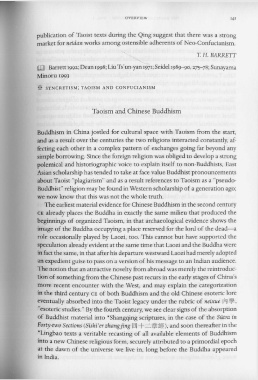Page 181 - The Encyclopedia of Taoism v1_A-L
P. 181
OVERVIEW 141
publication of Taoist texts during the Qing suggest that there was a strong
market for neidan works among ostensible adherents of Neo-Confucianism.
T. H. BARRETT
m Barrett 1992; Dean 1998; Liu Ts'un-yan 1971; Seidel 1989-90, 275-78; Sunayama
Minoru 1993
* SYNCRETISM; TAOISM AND CONFUCIANISM
Taoism and Chinese Buddhism
Buddhism in China jostled for cultural space with Taoism from the start,
and as a result over the centuries the two religions interacted constantly, af-
fecting each other in a complex pattern of exchanges going far beyond any
simple borrowing. Since the foreign religion was obliged to develop a strong
polemical and historiographic voice to explain itself to non-Buddhists, East
Asian scholarship has tended to take at face value Buddhist pronouncements
about Taoist "plagiarism" and as a result references to Taoism as a "pseudo-
Buddhist" religion may be found in Western scholarship of a generation ago;
we now know that this was not the whole truth.
The earliest material evidence for Chinese Buddhism in the second century
CE already places the Buddha in exactly the same milieu that produced the
beginnings of organized Taoism, in that archaeological evidence shows the
image of the Buddha occupying a place reserved for the lord of the dead-a
role occasionally played by Laozi, too. This cannot but have supported the
speculation already evident at the same time that Laozi and the Buddha were
in fact the same, in that after his departure westward Laozi had merely adopted
an expedient guise to pass on a version of his message to an Indian audience.
The notion that an attractive novelty from abroad was merely the reintroduc-
tion of something from the Chinese past recurs in the early stages of China's
more recent encounter with the West, and may explain the categorization
in the third century CE of both Buddhism and the old Chinese esoteric lore
eventually absorbed into the Taoist legacy under the rubric of neixue i*J ~,
"esoteric studies." By the fourth century, we see clear signs of the absorption
of Buddhist material into *Shangqing scriptures, in the case of the Sutra in
Forty-two Sections (Sishi'er zhangjing Il9 + =:!lH~ ), and soon thereafter in the
*Lingbao texts a veritable recasting of all available elements of Buddhism
into a new Chinese religious form, securely attributed to a primordial epoch
at the dawn of the universe we live in, long before the Buddha appeared
in India.

